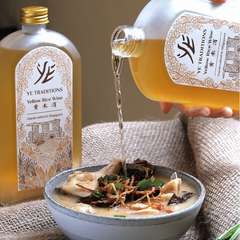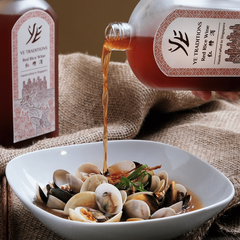Rice Wine: Naturally Sweet or Added Sugars?
If you've ever tasted rice wine, you might have noticed a distinct sweetness that sets it apart from other alcoholic beverages. But is rice wine naturally sweet, or is there more to the story? In this article, we'll explore what gives rice wine its unique flavor profile, why some rice wines taste sweeter than others, how to differentiate the brewers who add sugar and those who are all-natural, and how to choose the right one for your palate.
What Makes Rice Wine Sweet?
Rice wine, a popular beverage in many Asian cultures, is made by fermenting glutinous rice with water and a specific type of yeast, such as Aspergillus oryzae, which breaks down the rice starches into sugars. These sugars are then converted into alcohol by yeast during fermentation.
Unlike grape wines, where natural fruit sugars directly convert into alcohol, the sweetness in rice wine is a result of this two-step fermentation process. The combination of enzymes breaks down the starches (in glutinous rice) into simple sugars, creating that characteristic hint of sweetness.
Naturally Sweet or Added Sugars?
While rice wine can have a natural sweetness due to its fermentation process, not all rice wines are equally sweet. Here are a few factors that influence the level of sweetness:
-
Type of Rice Used:
Different types of rice have varying starch content, which can affect the final sweetness of the wine. Glutinous rice, for example, has a high starch content that breaks down into more sugar, often resulting in a sweeter wine. At Ye Traditions, we use glutinous rice for our rice wines, and the result is a natural sweetness. -
Fermentation Duration:
The length of the fermentation process plays a significant role in determining sweetness. A shorter fermentation time will leave more residual sugars, resulting in a sweeter taste, while a longer fermentation will convert more of these sugars into alcohol, yielding a drier wine. -
Temperature and Yeast Strains:
The temperature at which rice wine is fermented and the specific strains of yeast used can impact the level of sweetness. Warmer fermentation temperatures and certain yeast strains can produce a wine with more fruity or floral notes, which may enhance the perception of sweetness. -
Additives and Flavorings:
This is where I want to alert the readers! There are many commercial rice wine brands out there that have additional ingredients added to make it sweeter. You will know this when you see the label and it says "added sugar syrup". Given that the young and old consume this, we do not recommend choosing these commercial brands, and definitely recommend you read this article to learn more about tips to identify the better brands.
Sweetness in Different Types of Rice Wine
Rice wine comes in many varieties as we share in this article about red rice wine 红糟酒 and yellow rice wine 黄酒, and each has its unique flavor profile:
-
Shaoxing Wine (Chinese Rice Wine): Shaoxing wine, a popular cooking wine from China, has a deep, complex flavor with a slightly sweet, nutty taste. It is typically less sweet than other rice wines and is aged for varying lengths of time, which affects its sweetness. But as mentioned earlier, do keep a look out as many commercial brands use added sugars.
- Red rice wine 红糟酒 and Yellow rice wine 黄酒: Another variation of Chinese Glutinous Rice Wine is Ye Traditions red and yellow rice wine. Given that China is such a big country, different regions have their own variation and apart from the Shaoxing rice wine, there is Red Rice Wine from the Fuzhou, Fujian Province, and Yellow Rice Wine that originates from the Hakka people.
-
Mirin (Japanese Sweet Rice Wine): Mirin is a Japanese rice wine known for its natural sweetness and low alcohol content. It's often used in cooking to add depth and flavor to dishes like teriyaki and glazes.
-
Makgeolli (Korean Rice Wine): Makgeolli, a milky, unfiltered Korean rice wine, is naturally sweeter and has a slightly effervescent quality. It is often enjoyed as a refreshing drink and is known for its probiotic benefits due to the live cultures present in unfiltered varieties.
How to Choose a Rice Wine Based on Sweetness?
If you’re looking for a rice wine with a specific level of sweetness, consider the following tips:
-
For Cooking:
If you’re using rice wine primarily for cooking, a slightly sweet variety like yellow rice wine or mirin can enhance the flavors of your dishes. Red rice wine adds depth to savory dishes, while mirin brings a subtle sweetness perfect for glazes and marinades. -
For Sipping:
When choosing a rice wine for drinking, consider whether you prefer a sweeter or drier profile. Makgeolli offers a sweeter, creamier texture. -
For Desserts:
There are rice wines that are deliberately meant to be sweetened such as Fermented Glutinous Rice Wine 酒酿 (Jiu Niang). While the initial rice wine is naturally sweet, more sugar is added in the cooking process to make it even sweeter for dessert.

Conclusion: Sweetness in Balance
So, is rice wine naturally sweet? The answer is both yes and no. While the fermentation process does create a natural sweetness from the rice starches, the final flavor profile can vary widely depending on the type of rice, fermentation length, and additional ingredients. Whether you enjoy it sweet, dry, or somewhere in between, there’s a rice wine out there crafted to perfection for every taste.







Leave a comment